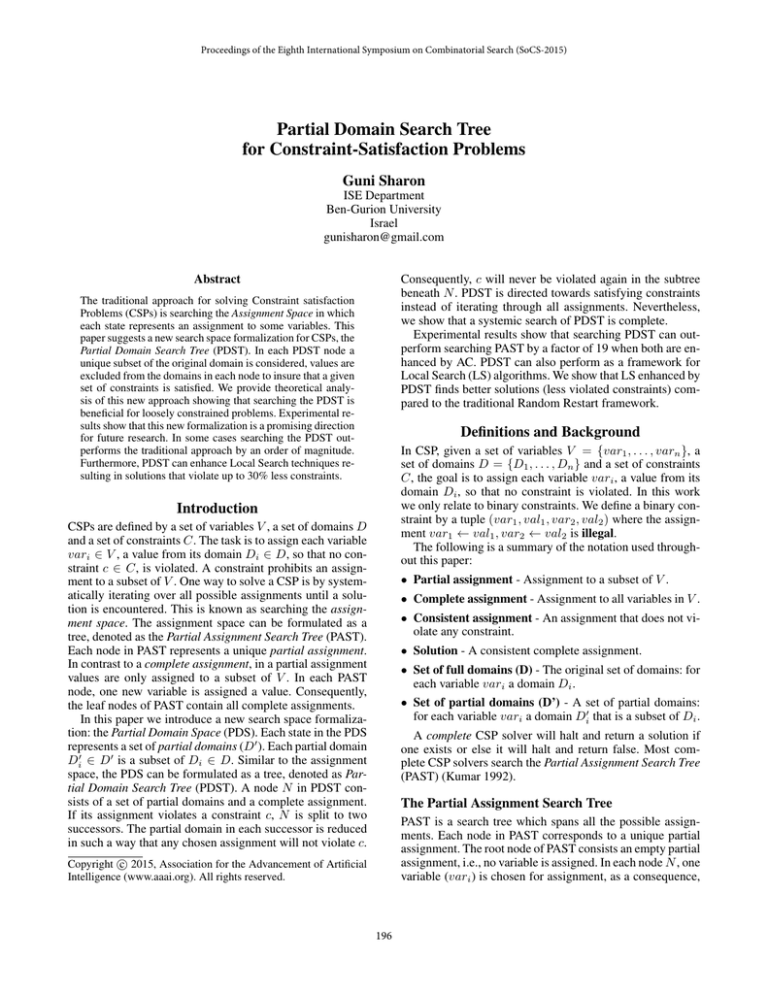
Proceedings of the Eighth International Symposium on Combinatorial Search (SoCS-2015)
Partial Domain Search Tree
for Constraint-Satisfaction Problems
Guni Sharon
ISE Department
Ben-Gurion University
Israel
gunisharon@gmail.com
Consequently, c will never be violated again in the subtree
beneath N . PDST is directed towards satisfying constraints
instead of iterating through all assignments. Nevertheless,
we show that a systemic search of PDST is complete.
Experimental results show that searching PDST can outperform searching PAST by a factor of 19 when both are enhanced by AC. PDST can also perform as a framework for
Local Search (LS) algorithms. We show that LS enhanced by
PDST finds better solutions (less violated constraints) compared to the traditional Random Restart framework.
Abstract
The traditional approach for solving Constraint satisfaction
Problems (CSPs) is searching the Assignment Space in which
each state represents an assignment to some variables. This
paper suggests a new search space formalization for CSPs, the
Partial Domain Search Tree (PDST). In each PDST node a
unique subset of the original domain is considered, values are
excluded from the domains in each node to insure that a given
set of constraints is satisfied. We provide theoretical analysis of this new approach showing that searching the PDST is
beneficial for loosely constrained problems. Experimental results show that this new formalization is a promising direction
for future research. In some cases searching the PDST outperforms the traditional approach by an order of magnitude.
Furthermore, PDST can enhance Local Search techniques resulting in solutions that violate up to 30% less constraints.
Definitions and Background
In CSP, given a set of variables V = {var1 , . . . , varn }, a
set of domains D = {D1 , . . . , Dn } and a set of constraints
C, the goal is to assign each variable vari , a value from its
domain Di , so that no constraint is violated. In this work
we only relate to binary constraints. We define a binary constraint by a tuple (var1 , val1 , var2 , val2 ) where the assignment var1 ← val1 , var2 ← val2 is illegal.
The following is a summary of the notation used throughout this paper:
Introduction
CSPs are defined by a set of variables V , a set of domains D
and a set of constraints C. The task is to assign each variable
vari ∈ V , a value from its domain Di ∈ D, so that no constraint c ∈ C, is violated. A constraint prohibits an assignment to a subset of V . One way to solve a CSP is by systematically iterating over all possible assignments until a solution is encountered. This is known as searching the assignment space. The assignment space can be formulated as a
tree, denoted as the Partial Assignment Search Tree (PAST).
Each node in PAST represents a unique partial assignment.
In contrast to a complete assignment, in a partial assignment
values are only assigned to a subset of V . In each PAST
node, one new variable is assigned a value. Consequently,
the leaf nodes of PAST contain all complete assignments.
In this paper we introduce a new search space formalization: the Partial Domain Space (PDS). Each state in the PDS
represents a set of partial domains (D0 ). Each partial domain
Di0 ∈ D0 is a subset of Di ∈ D. Similar to the assignment
space, the PDS can be formulated as a tree, denoted as Partial Domain Search Tree (PDST). A node N in PDST consists of a set of partial domains and a complete assignment.
If its assignment violates a constraint c, N is split to two
successors. The partial domain in each successor is reduced
in such a way that any chosen assignment will not violate c.
• Partial assignment - Assignment to a subset of V .
• Complete assignment - Assignment to all variables in V .
• Consistent assignment - An assignment that does not violate any constraint.
• Solution - A consistent complete assignment.
• Set of full domains (D) - The original set of domains: for
each variable vari a domain Di .
• Set of partial domains (D’) - A set of partial domains:
for each variable vari a domain Di0 that is a subset of Di .
A complete CSP solver will halt and return a solution if
one exists or else it will halt and return false. Most complete CSP solvers search the Partial Assignment Search Tree
(PAST) (Kumar 1992).
The Partial Assignment Search Tree
PAST is a search tree which spans all the possible assignments. Each node in PAST corresponds to a unique partial
assignment. The root node of PAST consists an empty partial
assignment, i.e., no variable is assigned. In each node N , one
variable (vari ) is chosen for assignment, as a consequence,
c 2015, Association for the Advancement of Artificial
Copyright Intelligence (www.aaai.org). All rights reserved.
196
it has Di unique successors. In each successor of N , vari is
assigned a unique value from Di . Since each node assigns
one variable, the depth of PAST is exactly |V |. All nodes at
depth |V | (the leaf nodes) consist of a complete assignment
that is potentially a solution.
Different CSP solvers that search PAST may use different
ordering of variables or values and different pruning techniques but they are all based on the backtrack (BT) algorithm
(AKA Depth-First Search) (Kumar 1992).
Many enhancements were presented to BT over the years,
for a comprehensive survey see (Ghdira 2013). Some of
these enhancements may also be applicable to other state
space representation. For instance, AC (Zhang and Yap
2001; Bessière and Régin 2001) can also be used to detect
infeasible partial domains, which are the focus of this paper.
Algorithm 1: Partial-Domain Backtrack
Input: Set of domains D0
0
1 A ← get assignment(D )
2 if A is consistent then
3
Return T RU E
4 c ← get constraint(A)
5 //Successor N1
0
6 if remove(D , c.var1 , c.val1 ) then
0
7
if AC(D ) then
8
if P DBT (D0 ) then
9
return T RU E
10
11
12
The Partial-Domain Search Tree
13
The partial-domain search tree (PDST) is a novel search
space formalization for CSPs that is a generalization of the
Conflict-Based Search algorithm for multi-agent pathfinding (Sharon et al. 2012; 2015).
14
15
16
Nodes in PDST
Each node in PDST consists of: (1) A set of partial domains
(D0 ) and (2) A complete assignment (not necessarily consistent). In the root node, D0 is equivalent to the original set of
domains, D, (i.e., ∀i : Di0 = Di ). The complete assignment
for each PDST node is chosen from D0 . In other words, every variable vari takes on a value from its current partial
domain Di0 . In a goal node the chosen complete assignment
is consistent, i.e., a solution. There are several ways that a
complete assignment can be chosen such as choosing an arbitrary assignment or using local search techniques that return a complete assignment. We say that a PDST node N ,
permits an assignment s, if for each variable vari , the value
it is given in s is part of Di0 . The root PDST node, for example, permits all possible assignments.
restore(D0 )
//Successor N2
if remove(D0 , c.var2 , c.val2 ) then
Dc.var1 = {c.val1 }
if AC(D0 ) then
if P DBT (D0 ) then
return T RU E
17
restore(D0 )
18
Return F ALSE
Observation 2 - If k is the set of leaf nodes that are descendants of N , each solution permitted by N must be permitted in exactly one node from k.
Observation 3 - A given node cannot permit a complete
assignment that is not permitted by all of its ancestors.
Theorem 1 PDST contains no duplicates.
Proof: Let Ni and Nj be two different nodes in PDST.
Case 1 - Ni and Nj are not on the same branch: Let
Na be the first common ancestor of Ni and Nj . Each successor of Na permits a set of complete assignments that is
disjoint from the set of the other (observation 1). Ni and Nj
cannot permit a complete assignment that is not permitted
by all their ancestors (observation 3). As a result the set of
assignments permitted by Ni and the set permitted by Nj
are disjoint and so each must have a unique partial domain.
Case 2 - One node (Ni ) is an ancestor of the other (Nj ):
The size of the domain of at least one variable is reduced between successive nodes. Consequently, at least one variable
has a bigger domain in Ni compared to Nj . As a result of
both cases, the set of partial domains of any two nodes must
be unique meaning no duplicates can exist. Searching PDST can be done using a variant of the backtrack (BT) algorithm denoted as Partial-Domain Backtrack.
Generating successors
Let N be a non goal PDST node. Since it is not a goal
node, the assignment of N violates at least one constraint
(var1 , val1 , var2 , val2 ) denoted as c. All solutions must satisfy c and so in any solution either var1 or var2 or both must
take a different assignment. In other words, all solutions
must belong to one of the following types: (Type 1) var1
is not assigned val1 and var2 is assigned val2 . (Type 2)
var2 is not assigned val2 and var1 is assigned val1 . (Type
3) Both var1 and var2 are not assigned val1 and val2 respectively. The different solution types are disjoint, i.e., any
solution belongs to one and only one type. Node N generates two successors, N1 and N2 , for covering all possible
solutions. At N1 , val1 is removed from D10 . This permits
all solutions of type 1 and 3. At N2 , val2 is removed from
D20 and all values except val1 are removed from D10 , forcing
var1 to take val1 . This permits all solutions of type 2.
Observation 1 - The set of complete assignments that is
permitted by one immediate successor is disjoint from the
set permitted by the other.
The Partial-Domain Backtrack Algorithm
Algorithm 1 presents a recursive variant of the PartialDomain Backtrack (PDBT) for searching PDST. We cover
PDBT line by line. Initially PDBT is called with D0 = D as
a parameter. This call corresponds to the root PDST node.
A complete assignment is chosen and assigned to variable
A (Line 1). Next, a goal test checking if A is consistent
197
Local Search
is performed (Line 2). Assume A violates the constraint
(var1 , val1 , var2 , val2 ) which is stored in c (Line 4). Two
successors are generated from the extracted constraint N1
and N2 . In successor N1 , the value val1 is removed from
D10 (Line 6). If val1 is the only remaining value in D10 , the
remove() function will return F ALSE, val1 will not be
removed and successor N1 will not be generated. AC is optional and can be called in order to further reduce the set of
domains or find it infeasible (Lines 7,14). If the recursive
call of N1 returns F ALSE, PDBT turns to generate N2 . At
N2 , val2 is removed from D20 (Line 12) and all variables
but val1 are removed from var1 (Line 13). If no solution is
found under N2 , F ALSE is returned.
So far we discussed complete algorithms that systematically
search the state space. Unfortunately, systematic search is
impractical for many CSP instances since the search space
is too big. These infeasible problems are commonly solved
using local search techniques (LS) which are usually very
fast but incomplete.
LS is initialized with a randomly selected complete assignment. Then, it attempts to iteratively decrease the number of violated constraints by changing a single assignment
at a time. If LS gets stuck in a local minima or a time bound
has expired a random restart procedure is performed. In random restart the assignment is initialized randomly or according to a heuristic that guesses a promising initial assignment
(Martı́ et al. 2013). Different LS variants may take different
approaches towards choosing the next assignment in a given
iteration while balancing between exploiting promising direction and exploring new areas of the search space (Hao
and Pannier 1998). PDBT can utilise LS as described next.
Theoretical Analysis
Assume a CSP with n variables where the domain size of
each variable is a constant d and there are t constraints.1 We
start by examining the size of PDST for this general problem. Each node in PDST enforces one constraint that will
never be violated in the subtree beneath it. Consequently,
the maximal depth of PDST is t. Since it is a binary tree,
the size of PDST is O(2t ) . Since there can be a constraint
between any pair of values, t = O([dn]2 ). Hence, the size
of PDST is exponential in (dn)2 .
For the same problem a PAST has a depth of n as each
level in the tree assigns one more variable. The branching
factor of PAST is d as each value is considered for each variable. Consequently, the size of PAST is O(dn ). In the worst
case scenario where the problem is dense with constraints
and t ≈ (dn)2 , n t and the size of PAST is smaller
compared to that of PDST. In practise, PDST is considerably smaller compared to PAST in many cases since t can
be very small compared to (dn)2 . Moreover, regardless of
the size of t, the root node of PDST may (fortunately) be
assigned a solution. And so, the size of the PDST in the best
case is 1 for any solvable problem. In fact, spanning a PDST
of size 2t requires a set of 2t bad assignment choices, in
most cases this is highly improbable. By contrast, the size
of the PAST in the best case, for a solvable problem, is d
since any solution must be at depth d. Nevertheless, PDBT
is a complete algorithm.
Using Local Search in PDBT
At each recursive call PDBT chooses a complete assignment out of the given set of partial domains (D0 ) by calling
get assignment(D0 ) (Line 1 of Algorithm 1). It is possible to implement this function using a LS solver in order to
retrieve a complete assignment. The chosen LS solver must
halt after a finite amount of time. Using LS will increase
the probability of finding a solution in each PDST node at
the cost of extra computational effort per node. When the
PDST is very large, using LS to try and find a solution at
early stages of the search is worthwhile. Note that unlike
the random restart procedure, the PDBT framework is complete and can identify unsolvable problems. The benefits of
using PDBT with LS are visible in the experimental evaluation section presented next.
Experimental Evaluation
Each problem setting is represented by a tuple (n, d, p1 , p2 )
where n is the number of variables, d is the domain size of
all variables, p1 is the probability that any pair of agents will
be in conflict (AKA density) and p2 is the probability that
any two values belonging to conflicting variables will be in
conflict (AKA tightness). For each problem setting 100 instances were generated. We report the average number of
constraint checks (CC) which is the number of times an assignment was verified to be allowed by a constraint. The BT
algorithm for PAST is denoted as PABT as opposed to the
BT algorithm for PDST (PDBT).
Theorem 2 PDBT is complete.
Proof: (1) Assume a general CSP instance with at least one
solution. Since the root PDST node permits all solutions any
solution must be permitted by one PDST leaf, Nl (Observation 2). The complete assignment in Nl must be a solution
otherwise Nl is not a leaf or doesn’t permit a solution. As
a systemic search PDBT must examine all PDST nodes and
Nl in particular.
(2) The size of PDST is finite (bounded by O(2t )). Since
PDST contains no duplicate nodes (Theorem 1) any systemic search algorithm, and PDBT as a special case, will
examine a finite number of nodes. PDBT Vs PABT
The first experiment compares basic PDBT and PABT (without AC). n was set to 15, d to 5 and the number of constraint
varied (different p1 and p2 values). Figure 1 presents CC
measurements (x-axis) as a function of different p2 values
(y-axis). Each frame presents results for a different p1 value
(0.1, 0.3, 0.5, 0.7).
Recall that the size of PDST is exponential in the number of constraints while the size of PAST is exponential in
1
The domain sizes of all variables are chosen to be constant
(= d) for the sake of discussion but in fact d can be viewed as the
size of the maximal domain over all variables.
198
Figure 1: PDBT Vs PABT. The average number of constraint checks performed (y-axis) for different p2 values (x-axis).
n
d
22
34
40
48
60
80
120
11
7
6
5
4
3
2
n
d
2.0
4.9
6.7
9.6
15.0
26.7
60.0
Constraint Checks
PABT
PDBT Ratio
106,643 236,146
0.45
193,718 282,912
0.68
690,066 955,283
0.72
362,424 441,732
0.82
157,343 102,447
1.54
241,005
25,358
9.50
672,133
34,636 19.41
P1
0.1
0.2
0.3
0.4
0.5
0.6
0.7
0.8
0.9
Total
Table 1: Constraint checks for PABT+AC and PDBT+AC.
the number of variables. This translates to the fact that the
relative performance of PDBT compared to PABT degrades
as the number of constraints increases and other parameters
are fixed. For low p1 values (0.1, 0.3), where variables are
loosely constrained, PDBT outperforms PABT. On the other
hand, when variables are tightly constrained (p1 > 0.4)
PABT prevails.
Violations
Hill Climbing
Simulated A.
RR PDBT
RR PDBT
84
62
82
58
242
204
247
208
422
369
436
381
613
524
637
546
812
722
846
751
1,015
901 1,058
938
1,223 1,094 1,274
1,141
1,434 1,138 1,494
1,209
1,646 1,317 1,715
1,386
832
703
865
735
Table 2: Number of violations for PDBT and RR.
two algorithms was used once under the random restart procedure (RR) and second under the PDBT framework.3
Table 2 presents the number of constraints violations in
the solutions returned by each of the algorithms within a
time bound of five seconds. In this experiment we set n =
100 and d = 20. p1 values are reported at the leftmost column. For each p1 value 900 instances were generated, 100
for each p2 value.
In total, PDBT finds better solutions (with less violated
constraints) compared to RR across all the P1 range.
Using Arc-Consistency
The second experiment compared PDBT and PABT when
both use AC3.1 (Zhang and Yap 2001) to detect and prune
invalid partial assignments/domains. The values of n and d
varied while for each pair of (n, d) all p1 and p2 combinations were used where p1 , p2 ∈ {0.1, 0.2, ..., 0.9}. Though
n and d varied, the value of (dn) was set to 240 in order to
keep a controlled environment with regard to the growth in
the size of PDST (exponential in [dn]2 ). Each row presents
the average of over 81 (p1 , p2 ) combinations and 8100 instances. In this experiment we considered only instances that
are solvable since they are Arc Consistent. Both algorithms
will identify an instance that is not Arc Consistent immediately, making those instances irrelevant.
Table 1 presents the CC measurements for both algorithms (best value in each line is given in bold). The ratio
n/d is also given and presents a positive correlation with the
relative performance of PDBT. As n/d increases so does the
CC ratio between PABT and PDBT. n/d = 10 is a crossover
point after which PDBT outperforms PABT.
Discussion and future work
This paper presents a new formalization and a corresponding
search tree for CSPs denoted as the Partial Domain Search
Tree (PDST) that is based on the CBS algorithm (Sharon
et al. 2015). The traditional Partial Assignment Search Tree
(PAST) was the focus of extensive research and many enhancements were introduced to it over the years. PDBT in
its current/basic form is not competitive with state-of-the-art
PABT solvers. The empirical results suggest that when both
PDBT and PABT use the same enhancement (AC), the first
can outperform the later by more than an order of magnitude
in some cases. For other cases, where variables are tightly
constrained, the traditional PABT approach prevails. Adapting more enhancements as well as coming up with new special enhancements for PDBT is left for future work.
PDBT shows promising results as a Local Search framework where it is able to find better solutions (less violated
constraints) compared to the Random Restart approach.
Local Search
The third experiment shows the benefits of using PDBT with
LS. Two LS solvers were used: the Hill Climbing algorithm
(HC) (Selman et al. 1992) and the more advanced Simulated
Annealing algorithm (Hao and Pannier 1998).2 Each of the
2
Simulated Annealing was set using The Metropolis acceptance
criterion (Metropolis et al. 1953) with a temperature parameter = 1
and was bounded to 1,000 steps.
3
In our experiments PDBT used AC3.1 (Zhang and Yap 2001)
to detect and prune infeasible sets of partial domains.
199
Acknowledgments
We would like to thank: Ariel Felner, Roie Ziven and Malte
Helmert for their advice and help on this issue.
References
Christian Bessière and Jean-Charles Régin. Refining the basic constraint propagation algorithm. In IJCAI, pages 309–
315, 2001.
Khaled Ghdira. Constraint Satisfaction Problems: CSP Formalisms and Techniques. Wiley, 2013.
Jin-kao Hao and Jerome Pannier. Simulated annealing and
tabu search for constraint solving. In Symposium on Artificial Intelligence and Mathematics. Citeseer, 1998.
Vipin Kumar. Algorithms for constraint-satisfaction problems: A survey. AI magazine, 13(1):32, 1992.
Rafael Martı́, Mauricio GC Resende, and Celso C Ribeiro.
Multi-start methods for combinatorial optimization. European Journal of Operational Research, 226(1):1–8, 2013.
Nicholas Metropolis, Arianna W Rosenbluth, Marshall N
Rosenbluth, Augusta H Teller, and Edward Teller. Equation of state calculations by fast computing machines. The
journal of chemical physics, 21(6):1087–1092, 1953.
Bart Selman, Hector J Levesque, and David G Mitchell.
A new method for solving hard satisfiability problems. In
AAAI, volume 92, pages 440–446, 1992.
Guni Sharon, Roni Stern, Ariel Felner, and Nathan R. Sturtevant. Conflict-based search for optimal multi-agent path
finding. In AAAI, 2012.
Guni Sharon, Roni Stern, Ariel Felner, and Nathan R.
Sturtevant. Conflict-based search for optimal multi-agent
pathfinding. Artif. Intell., 219:40–66, 2015.
Yuanlin Zhang and Roland HC Yap. Making ac-3 an optimal
algorithm. In IJCAI, pages 316–321, 2001.
200








